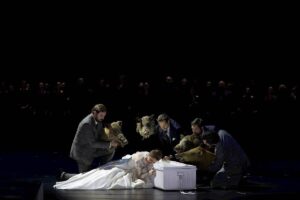Giuseppe Verdi’s “I vespri siciliani” recounts the story of a historical revolution: the uprising of the Sicilian people against their French rulers in 1282, leading to the liberation of the island from their occupation. The political narrative is intertwined with the personal lives of the main characters. Duchess Elena, whose brother was killed by the French, seeks vengeance with the help of the young hero Arrigo.
In true feuilleton style, Arrigo turns out to be the long-lost son of Monforte, the French ruler of Sicily and the opera’s villain. Calixto Bieito is Calixto Bieito None of this was discernible on the Zurich Opernhaus stage. Director Calixto Bieito chooses a setting outside of time and space.

The sets, designed by Aída-Leonor Guardia , feature a black space filled with shipping containers that open to represent various rooms and enclosed spaces. The costumes by Ingo Krüler are modern: the French occupiers, all men, wear suits, while the Sicilians are dressed in simple black outfits. None of the visuals seem connected to the plot, and the reason is clearly explained by Bieito in the program.
He relies on personal images from his childhood experiences, resulting in a navel-gazing production—a solipsistic exercise that is difficult for anyone else to relate to. The main focus seems to be violence against women. Exploiting the libretto’s reference to the rape of the Sabine women by the Romans, and the occupiers’ ensuing violence against three brides d.
















